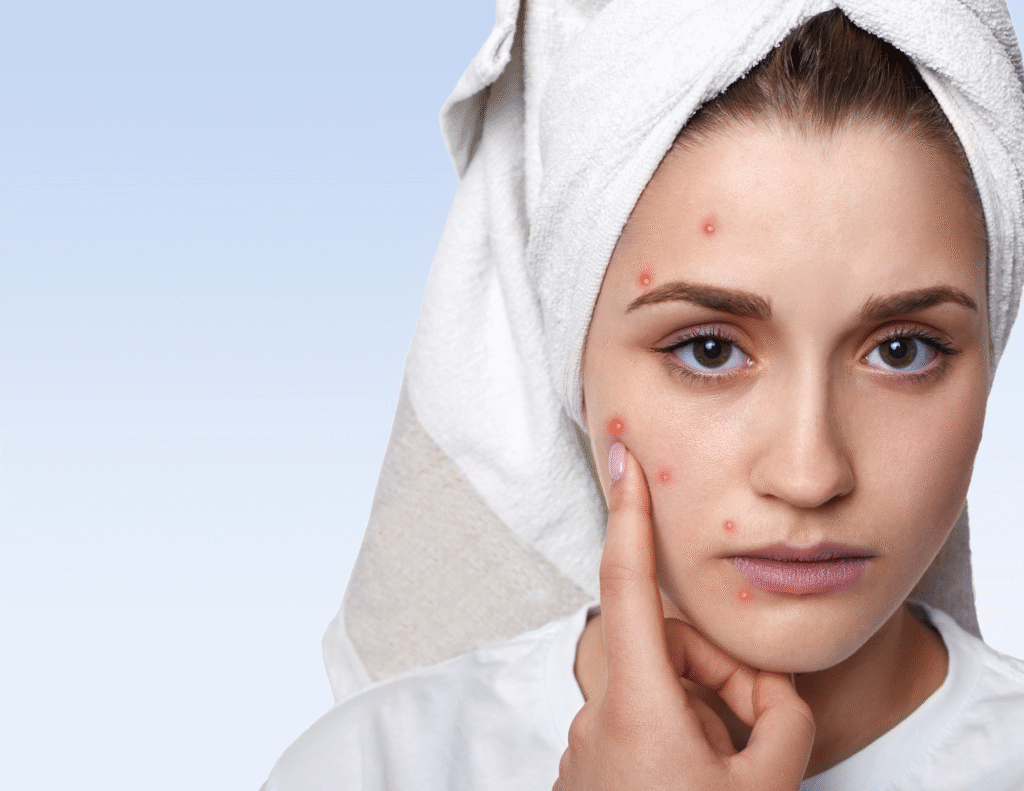Refresh and Heal Your Skin to Combat Breakouts and Scarring in New Jersey
Acne can be a persistent and frustrating skin condition, affecting millions of people at some point in their lives, often during adolescence and young adulthood. At Skin & Laser Center of NJ, we provide advanced, personalized acne treatments designed to target breakouts, reduce inflammation, and prevent long-term scarring. Our board-certified dermatologists develop individualized treatment plans to address each patient’s specific type and severity of acne, helping patients across New Jersey achieve healthier, clearer skin.


Acne occurs when pores become clogged with oil, dead skin cells, and bacteria, creating an environment conducive to inflammation. This can result in:
Whiteheads and blackheads: Non-inflammatory blemishes caused by clogged pores
Papules and pustules: Small red bumps or pus-filled lesions caused by inflammation
Nodules and cysts: Deeper, often painful lesions that can lead to scarring if untreated
Factors that contribute to acne include hormonal fluctuations, stress, genetics, diet, certain medications, and the use of skincare or cosmetic products that clog pores. Understanding these underlying causes is crucial to developing an effective treatment strategy. Our dermatologists evaluate each patient’s triggers and symptoms to ensure that every acne treatment plan is customized for maximum results.
At Skin & Laser Center of NJ, we offer a comprehensive suite of acne treatments designed to target the root causes of breakouts and promote long-term skin health. Treatment options include:
Photodynamic Therapy (PDT): Uses light-activated medication to reduce inflammation and kill acne-causing bacteria
Chemical Peels: Exfoliate the skin to unclog pores, improve texture, and reduce acne-related hyperpigmentation
Laser Acne Treatments: Target inflammation, bacteria, and excess oil to reduce active breakouts and prevent future lesions
Topical Medications: Prescription creams or gels that decrease oil production and target bacteria
Oral Medications: Antibiotics or hormonal therapies for moderate to severe acne
Our dermatologists often combine multiple treatments to optimize results, ensuring that both active acne and potential scarring are addressed. Treatments may require multiple sessions, and follow-up care is essential for maintaining clear, healthy skin.


Successful acne treatment involves more than just addressing individual breakouts—it requires ongoing management and prevention strategies. At Skin & Laser Center of NJ, we provide:
Comprehensive evaluation of your skin type, acne severity, and underlying causes
Customized treatment plans combining medical therapies, laser procedures, and chemical peels
Guidance on daily skincare routines, product selection, and lifestyle modifications to reduce flare-ups
Regular follow-up appointments to monitor progress and adjust treatment as needed
By taking a holistic approach, we help patients maintain long-term skin health while minimizing the risk of scarring and future acne outbreaks.
Learn More About Our Acne Treatments
Photodynamic therapy (PDT) is a procedure for addressing a range of skin conditions including acne, inflammatory rosacea, sun damage, and photoaging. For photodynamic acne treatment, you will be asked to arrive before your appointment begins. Your skin will be cleansed and may be covered in a medicated solution called Ameluz. You will wait an hour or two while your skin absorbs the medicine, during which you can read or watch a show on your tablet or phone.
Next, the medication will be rinsed off, and you will be placed under a light for roughly 10 to 20 minutes. The light activates the medication, which kills the bacteria that causes acne and reduces the size and activity of the sebaceous glands that produce pore-clogging and bacteria-feeding oil. In total, the appointment can take about two hours, including the time it takes to absorb the Ameluz.
Within a few days of the treatment, your skin will begin to crust and scab. It’s very important to wear sunscreen and avoid the sun in the weeks right after your photodynamic therapy acne treatment. Your skin will be particularly sensitive following your appointment, so it’s important to protect your skin and give it time to heal.
For optimal results, many patients require three to four treatments spaced three to four weeks apart. More severe cases may require five treatment sessions. Your provider will discuss the estimated number of treatments with you while developing your treatment plan during your consultation.
A chemical peel is another procedure used to address a variety of skin concerns, including acne, fine lines, acne scars, discoloration, and other surface changes. At the beginning of the appointment, your provider will clean your skin with a gentle cleanser before applying a chemical solution to the treatment area. This will cause your skin to redden, followed by a localized sensation of tightness. The outermost layer of skin will eventually peel off over the course of five to 10 days. Depending on which type of peel you receive and the size of the area being treated, the entire appointment may take between 10 and 40 minutes.
The degree and duration of the peel will vary based on the strength of the peel. The new, regenerated skin is usually smoother and less wrinkled than the old skin, but is temporarily more sensitive to the sun.
The peel process continues long after the appointment is over. Following your peel it’s important to follow your provider’s aftercare instructions, including avoiding exfoliants and retinoid creams, minimizing sun exposure, avoiding smoking (as it can prolong the healing time and cause an infection), and avoid peeling the skin.
Convenient walk in hours available below. No appointment needed! Accepting private insurance and medicare. No medicaid plans.
Learn more about medical treatments at New Jersey’s Skin & Laser Center of NJ. Call 201-500-7525 or contact us online to schedule a consultation.